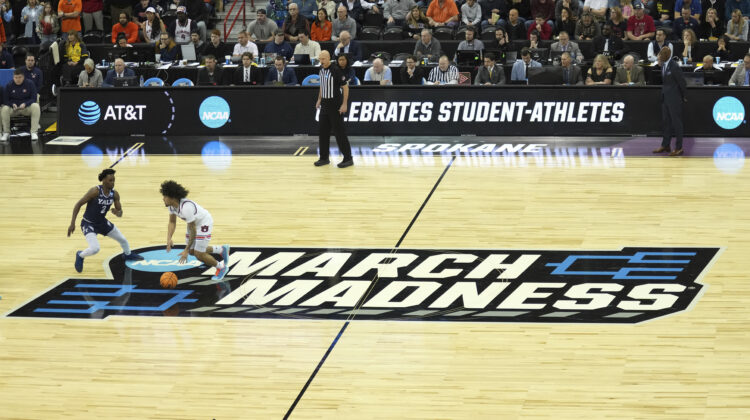Welcome to the Hotline’s early forecast for the 2024-25 season — a season notable in two specific regards:
— The new conference configurations, which will include: USC, UCLA, Oregon and Washington in the Big Ten; Arizona, ASU, Utah and Colorado in the Big 12; Cal and Stanford in the ACC (along with SMU); and Washington State and Oregon State in the West Coast Conference as affiliate members but eligible for the championship.
— The last hurrah for the COVID kids. Players who received a free year of eligibility due to the pandemic season of 2020-21 will compete in their fifth and final year. Many figure to play key roles in shaping conference races across the country.
The following rankings rely on a series of assumptions about NBA Draft decisions and, of course, transfer portal movement.
By the end of April, we should have clarity on rosters and will adjust the rankings accordingly.
Also considered: Boise State, Clemson, Colorado, Colorado State, Grand Canyon, Illinois, Indiana State, James Madison, Marquette, McNeese State, Michigan State, N.C. State, Nebraska, Oakland, Oregon, Pittsburgh, Saint Mary’s, South Carolina, TCU, Texas, Texas Tech, Texas A&M, Villanova and Xavier.
1. Duke. With pressure building headed into the third season of Jon Scheyer’s tenure, the Blue Devils appear well-equipped for a title run. Forward Cooper Flagg, the top recruit to enter college basketball in years, will be the catalyst surrounded by five-star talents — some newcomers, some returnees. The roster is beyond loaded.
2. Connecticut. The dominant team of the past 13 months will lose big man Donovan Clingan and guards Tristen Newton and Stephon Castle to the NBA. But coach Danny Hurley’s program won’t leave the national stage, for the Huskies are stocked with blue-chip talents awaiting their turn. The list includes forward Jaylin Stewart, the top prep player in Washington state a year ago.
3. Baylor. Our assumption is that Ja’Kobe Walter takes his talents to the NBA. No matter. The Bears are set to win the expanded Big 12 and make a run at the Final Four with guard Langston Love and a stellar recruiting class. (Forward Jalen Bridges has eligibility remaining but might not use it.) If coach Scott Drew leaves for Kentucky, we will reassess Baylor’s outlook.
4. Alabama. A glorious postseason in Tuscaloosa turned fraught when John Calipari left Kentucky for Arkansas on Sunday night, leading to speculation that Nate Oats would skip town to Lexington. (His buyout is $18 million, but Kentucky can afford it.) If Oats stays in Tuscaloosa and guard Mark Sears returns to join Grant Nelson, Latrell Wrightsell Jr. and Rylan Griffen, the Tide could be back in the Final Four.
5. Iowa State. Yes, the Big 12 will be loaded next season, with ISU and Baylor as the early favorites — not Kansas or Arizona. Our Ames outlook assumes guards Tamin Lipsey and Keshon Gilbert return as the heart of a first-class perimeter defense. Any improvement offensively would do wonders for the Cyclones next March after they fell three points short of the Elite Eight.
6. Gonzaga. A retooled roster that found its groove late in the season should pick up where it left off, especially if guard Ryan Nembhard returns. The Zags possess all the frontline production they need with Graham Ike (assuming he comes back) and Pepperdine transfer Michael Ajayi. And it’s a given that Mark Few will add more talent from the transfer portal.
7. Tennessee. There’s no reason to believe guard Dalton Knecht is returning, otherwise we would have slotted the Vols in the top three. (He’s a lock for the first round of the NBA Draft.) But a team that pushed Purdue in the Elite Eight has plenty of reason for optimism, starting with guard Zakai Zeigler and big men Tobe Awake and Jonas Aidoo.
8. North Carolina. Armando Bacot’s 27-year college career finally comes to a close. But what of high-scoring guard RJ Davis, who has eligibility remaining? He’s the key to a stellar season for Hubert Davis and Co., along with forward Harrison Ingram. The recruiting class includes two of the top-10 prospects in the country.
9. Brigham Young. Our first sleeper pick, to the extent a team that won 23 games and earned a No. 6 seed in the NCAAs can be considered a sleeper. The outlook in Provo hinges on guard Jaxson Robinson’s stay-or-go decision. If he returns, the Cougars will have four double-digit scorers as the core for their sophomore year in the Big 12.
10. Kentucky. We had the Wildcats comfortably slotted in the top five during the first draft of these rankings. But the news of Calipari’s departure has added a massive layer of uncertainty. The projected roster could stay largely intact, it could evaporate completely, or it could evaporate and reform. Everything depends on the identity of Calipari’s replacement.
11. Wake Forest. Our second sleeper pick won 21 games, did not make the NCAAs and is scheduled to return its top-four scorers, with guard Hunter Sallis once again in the leading role. Coach Steve Forbes will have the best team of his five-year tenure in Winston Salem.
12. Purdue. The Boilermakers’ lineup will get smaller next season — by a whopping two inches. Get ready for the era of Will Berg, a 7-foot-2 freshman from Sweden who played sparingly this season. And don’t forget that guards Fletcher Loyer and Braden Smith are just sophomores, so the supporting cast for Zach Edey is set to take on a leading role.
13. Rutgers. Our third sleeper won a mere 15 games and finished far closer to the bottom of the Big Ten than the top. But amazingly, the Scarlet Knights have signed the top recruits in the country at two positions: small forward Ace Bailey and wing guard Dylan Harper. Welcome to the world of the relevant.
14. Houston. The Jamal Shead era ended with a sprained ankle in the Sweet 16, but there is zero reason to doubt coach Kelvin Sampson’s ability to quickly retool his roster. You don’t average 30 wins a year for six years unless the program is built on granite. Doubt the Cougars at your peril.
15. Auburn. The Tigers’ ignominious departure from the NCAAs — recall their first-round loss to Yale — is not reason enough to exclude Auburn from our early top 25. But if star center Johni Broome opts for the NBA Draft, we might reconsider its position.
16. Creighton. The Bluejays won’t have Baylor Scheierman next season, but Trey Alexander and Ryan Kalkbrenner have eligibility remaining, as does Stephen Ashworth. The regression in Omaha could be slight — or nonexistent.
17. Seton Hall. The calculation behind our fourth sleeper selection is not complicated: The Pirates finished as the NIT champs, with experience and momentum that will help immensely next season. Also, Shaheen Holloway is a terrific coach.
18. Kansas. The Jayhawks haven’t been this low in our projections in eons, but the level of uncertainty in Lawrence is unusually high. Although Kevin McCullar Jr. is out of eligibility, center Hunter Dickinson has the option to return. Will he? And how will Bill Self address other roster weaknesses?
19. Florida. We like what second-year coach Todd Golden is building in Gainesville, but continued momentum hinges on Walter Clayton Jr and Will Richard returning.
20. Arizona: Recent history suggests coach Tommy Lloyd will use the transfer portal to deftly restock his roster, which won’t include Caleb Love, Pelle Larsson or Oumar Ballo and could very well orbit around Jaden Bradley, who was terrific in the postseason. Next season will be fascinating on so many levels.
21. St. John’s. The Red Storm can only be considered a sleeper if you ignore that Rick Pitino is the head coach and will have had two recruiting cycles to upgrade the roster.
22. Syracuse. Coach Adrian Autry has been quietly assembling quality transfers and recruits. Next season — his second since replacing Jim Boeheim — should result in a breakthrough for the once-elite program.
23. San Diego State. The Aztecs had an unusual situation in which one player averaged more than 20 points per game and nobody else was in double figures. That player, forward Jaedon LeDee, is out of eligibility. As a result, our somewhat bright outlook for SDSU requires a small leap of faith that coach Brian Dutcher will replace the lost production.
24. UCLA. With a disappointing season and the move into the Big Ten serving as backdrops, the Bruins need to recreate the upward trajectory of Mick Cronin’s early years in Westwood. Adem Bona’s return would be a good place to start that process.
25. Texas A&M. There are enough returning pieces from the rotation that took Houston to overtime in the second-round thriller — guard Wade Taylor IV has eligibility remaining, for example — to keep the Aggies relevant in the SEC.
*** Send suggestions, comments and tips (confidentiality guaranteed) to pac12hotline@bayareanewsgroup.
*** Follow me on Twitter/X: @WilnerHotline
*** Pac-12 Hotline is not endorsed or sponsored by the Pac-12 Conference, and the views expressed herein do not necessarily reflect the views of the Conference.
Related posts:

(AP Photo/Ralph Freso, File)
Wilner – Today’s Big 12 Makeover, Impact on Pac-12 Pac-12 bowl projections: USC to the playoff while Washington is left to ponder a giant ‘what if’
Pac-12 bowl projections: USC to the playoff while Washington is left to ponder a giant ‘what if’
 Hotline mailbag: Peeking at the ’23 schedules, expansion timeline, buyer’s remorse in L.A.(?) and loads more
Hotline mailbag: Peeking at the ’23 schedules, expansion timeline, buyer’s remorse in L.A.(?) and loads more
 Pac-12 financial mess: On the fate of the networks, an emergency recourse and the legal framework
Pac-12 financial mess: On the fate of the networks, an emergency recourse and the legal framework


